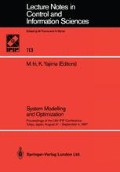Abstract
In this paper we have analyzed the relationships between economic growth and transportation supply in a multiregional multisectoral system. We have provided tools for identifying possible bottlenecks in transportation infrastructure which hamper development possibilities for some regions, and proposed a general method for tackling the problem of augmenting the transportation network in order to achieve balanced growth with either the minimum cost or the minimum number of links added. Our work has been based on the analysis, in terms of dynamic equilibrium properties of the system, of the trade patterns resulting from the matching of regional demands and the provision of transportation infrastructure. This does not limit the generality of the results since we have mainly dealt with the topological structure of the problem. However, the dimensions of trade coefficientes and physical flows determine the actual solution of the eigenvalue problem: although of great relevance in practice, this subject has not been tackled here, leaving room for further work.
Preview
Unable to display preview. Download preview PDF.
References
H. ADLER (1971): Economic Appraisal of Transport Projects: A manual with Cases Studies. Indiana University Press, Bloomington, Indiana.
S. ANAND (1975): Appraisal of Highway project in Malaysia: Use of the Little-Mirles Procedure. Working Paper 213. International Bank for Reconstruction and Development, Washington, D.C.
P.S. ARMINGTON (1963): A Theory for Products Distinguished by Place of Production. International Monetary Fund Staff Papers, 16, 159–176.
D. BATTEN, D. MARTELLATO (1984): Classical Versus Modern Approaches to Interregional Input-Output Analysis. Paper presented at the 24th European Congress of RSA. Milan, 28–31 August.
U. BLUM (1982): Effects of Transportation Investments on Regional Growth: a theoretical and Empirical Investigation. Papers of The Regional Science Association, 49, 169–174.
D. CAMPISI, A. LA BELLA (1987a): An Input-Output Based Approach to the Short-Term Evaluation of Transportation Plans. Applied Mathematical Modelling, 11, 2, 127–132.
D. CAMPISI, A. LA BELLA (1987b): Transportation supply and economic growth in a multiregional system. IASI Research Report R 181. In press: Environment and Planning A.
F. DUCHIN, D.B. SZYLD (1986): A Dynamic Input-Output Model with Assumed Positive Output, Metroeconomica, 269–282.
J. EDMONS (1967): Optimum Branching, J. Res. Nat. Bur. Standards, Sect B, 71, 233–260
K.P.E. ESWARAN, E. TARJAN (1976): Augmentation Problems — Siam J. Comp., 5, 653–665
G.N. FREDERICKSON and J. JA'JA (1984): Approximate Algorithms for Several Graph Augmentation Problems. Siam J. Comput., Vol. 10, No. 2, 270–283.
F.R. GANTMACHER (1959): Applications of the Theory of Matrices. N.Y. Interscience.
R.A. HORN, C.A. JOHNSON (1985): Matrix Analysis, Cambridge University Press.
Y. KAJITANI, S. UENO (1986): The Minimum Augmentation of a Directed Tree to a K-Edge Connected Directed Graph. Networks, 16, 181–197.
Y. KANEMOTO and K. MERA (1983): General Equilibrium Analysis of the Benefits of large Transportation Improvements, Discussion Paper, Institute of Socio-Economic Planning, University of Tsukuba.
W. ISARD (1951): Interregional and Regional Input-Output Analysis: A Model of a Space-Economy, Review of Economics and Statistics 33, 318–328.
A. LA BELLA (1986): Integrated Transportation Planning: Physical Expansion Versus Economic Constraints, in (P. Nijkamp, S. Reichmann eds.): Transportation Planning in a Changing World. Gower, London, 243–253.
W. LEONTIEF (1977): The Dynamic Inverse, in Contribution to Input-Output Analysis (A.P. Carter and A. Brody eds.) Amsterdam: North-Holland Publishing Co. 1970, pp. 17–46, reprinted in Wassily Leontief, Essays in Economics, Volume 2. White Plans, N.Y.: M.E. Sharpe 1977.
W. LEONTIEF and A. STROUT (1963): Multiregional Input-Output Analysis, in (T. Barna, ed.), Structural Interdipendence and Economic Development, McMillan, London.
C.K. LIEW and C.J. LIEW (1984 a): Measuring the Development Impact of a Proposed Transportation System, Regional Science and Urban Economics, 14, 175–198.
C.K. LIEW and C.J. LIEW (1984 b): Multi-Modal, Multi-Output, Multiregional Variable Input-Output Model, Regional Science and Urban Economics, 14, 265–281.
C.K. LIEW and C.J. LIEW (1985): Measuring the Development Impact of a Transportation System: A Simplified Approach, Journal of Regional Science, 25, 241–258.
D.G. LUENBERGER and AMI ARBEL (1977): Singular Dynamic Leontief Systems, Econometrica, 45, 991–995.
U. MEYER (1982): Why Singularity of Dynamic Leontief System Doesn't Matter, in Input-Output Techniques, Proceedings of the third Hungarian Confernece on Input-Output Techniques, 3–5 November 1981. Budapest: Statistical Publishing House, 181–189.
H. NIKAIDO (1968): Convex Structures and Economic Theory-Academic Press.
P. PRASTACOS and M. ROMANOS (1987): A Multiregional Model for Allocating Transportation Investments. Transportation Research-B, 2, 133–148.
K. SASAKI (1983): A Household Production Approach to the Evaluation Of Transportation System Change. Regional Science and Urban Economics, 13, 241–249.
D. B. SZYLD (1985): Conditions for the Existence of a Balanced Growth Solution for the Leontief Dynamic Input-Output Model, Econometrica, 53, 6, 1411–1419.
H. TULKENS and T. KIONI KABANTU (1983): A Planning Process for the Efficient Allocation of Resources to Transportation Infrastructure, in J.F. Thisse and H.G. Zoller (Eds.), Locational Analysis of Public Facilities, North-Holland, 127–152.
Author information
Authors and Affiliations
Editor information
Rights and permissions
Copyright information
© 1988 International Federation for Information Processing
About this paper
Cite this paper
Campisi, D., La Bella, A. (1988). Transportation investment and dynamic equilibrium in a multiregional input-output system. In: Iri, M., Yajima, K. (eds) System Modelling and Optimization. Lecture Notes in Control and Information Sciences, vol 113. Springer, Berlin, Heidelberg. https://doi.org/10.1007/BFb0042810
Download citation
DOI: https://doi.org/10.1007/BFb0042810
Published:
Publisher Name: Springer, Berlin, Heidelberg
Print ISBN: 978-3-540-19238-1
Online ISBN: 978-3-540-39164-7
eBook Packages: Springer Book Archive

